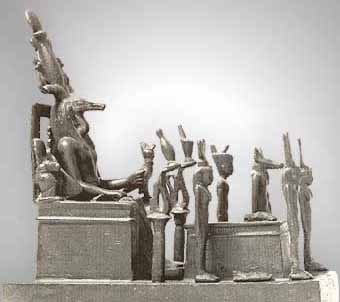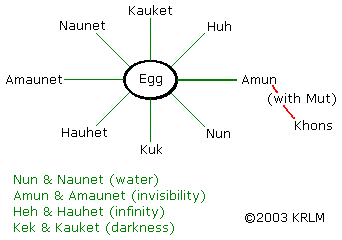
Ogdoad
In Egyptian mythology, the Ogdoad are the eight deities worshipped in Hermopolis. The gods of the Ogdoad were mostly seen as humans with their animals' heads, or just depicted as snakes and frogs. They were arranged in four male-female pairs, with the males associated with frogs, and the females with snakes. [frogs are assciated with biogenetic experiments. [Snakes represent human DNA]
The Egyptians believed that before the world was formed, there was a watery mass of dark, directionless chaos. In this chaos lived the Ogdoad of Khmunu (Hermopolis), four frog gods and four snake goddesses of chaos. [Balance in infinity]
These deities were Nun and Naunet (water), Amun and Amaunet (invisibility), Heh and Hauhet (infinity) and Kek and Kauket (darkness).
The chaos existed without the light, and thus Kek and Kauket came to represent this darkness. They also symbolized obscurity, the kind of obscurity that went with darkness, and night.
The Ogdoad were the original great gods of Iunu (On, Heliopolis) where they were thought to have helped with creation, then died and retired to the land of the dead where they continued to make the Nile flow and the sun rise every day.
Because of this aspect of the eight, Budge believe that Kek and Kauket were once deities linked to Khnum and Satet, to Hapi - Nile gods of Abu (Elephantine). He also believed that Kek may have also been linked to Sobek.

HISTORY OF THE OGDOAD
The name of eight Egyptian deities who were especially worshipped in Hermopolis in Upper Egypt. They form the basis of the creation myth. The Ogdoad consist of four gods and four goddesses who together personify the essence of the primordial chaos before the creation of the world. They are Nun and Naunet (the primordial water), Huh and Hauhet (infinite space), Kuk and Kauket (darkness), and Amun and Amaunet (representing hidden powers).
From themselves they created the mound upon which lay the egg from which the sun god emerged. The gods of the Ogdoad are represented as frogs or with the head of a frog; the goddesses in the shape of a snake or as a woman with the head of a snake. Their cult centered on the town of Khemnu (Greek Hermopolis) in Middle Egypt. They also had a sanctuary at Medinet Habu in western Thebes.